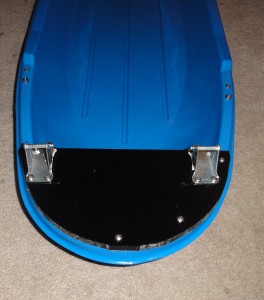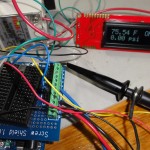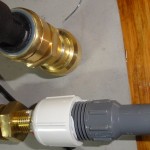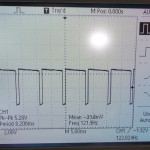I had a 0.5 inch piece of acrylic scrap from Tap Plastics. I traced the nose and cutout the curve, then bolted the flanges from fixed caster mounts. I used these 2 inch casters from Amazon.
Homemade Pulk
Started building my home made pulk. Bruce picked up a couple sleds from Target. I am trying CPVC under the rim to spread the load when being pulled and add some rigidity. I picked up some fixed casters from Amazon. After the wheels removed the bolt (axel) can be put back in place. I will use these as the anchor points.
Front sensors on a Pololu Zumo
I’m starting to outfit sensors on my black Friday Zumo (mini sumo). The Zumo is small, finding ways of securely mounting sensors is a challenge. I started by bending the center section between anchor screws of the wedge that Pololu sells up, then tapping it for screws to hold a Sharp IR sensor.
I also added spacers to fit a Wixel shield upside down. Score!
Sheridan Peak W7/NC-009
Wrote a small blog entry for PNW SOTA’s website about Sheridan Peak,
Pololu Zumo
Out of all the black friday sales, Pololu is my favorite. They usually offer one or two items at a good deal…but more importantly it’s something that I’m interested in. This year they are offering a nearly 40% discount on their new Zumo which is an off the shelf mini-sumo class robot that docks to an Arduino. It does not come with sensors, so expect to put up some additional cash for sensors. The only really quirky aspect of the Zumo is the shield mates to the Arduino when it is upside down.
Finishing the pump controller
It’s been a busy summer. Next weekend I’m travelling down to the cabin. I keep telling myself it would be really nice to get the pump controller working. I spent some this weekend ironing out a few bugs–and creaking a mock to test it.
Mostly battling this stupid SSR. While the label says it takes 3VDC as control, I’ve found it takes at least 5 and better 6 volts to adequately turn on. At first I thought I burnt out the FloJet pump, but it was the SSR not fully triggering (only at a lower level).
Tonight I fixed the hysteresis feature (millis() is my friend). There is more work to do to finish out a feature features: (1) the manual overide switch (2) add a menu item to set the hysteresis time (3) test!
Calibration curve for Sensata pressure sensor
Arduino based water pressure controller
I started playing around with the idea of using an Arduino based water pressure controller because of fears of the common and ubiquitous Square D pressure switch failing. There are many accounts of how these switches fail after only a few years. If you are switching DC voltages, then they fail faster.
The primary goal of this project:
- Use a variable pressure sensor, not a switch with a longer lifetime
- Provide over heating protection via a remote temperature sensor
- Use a float switch to detect when the resevoir tank is empty
I’ve started making some headway on this. I have an LCD displaying status, and I picked up two Sensata 67CP sensors on ebay. These Sensata sensors are probably for a hydraulic application, my friend John thinks. The smaller threading is 5/16-24. I purchased a brass PEX end cap, drilled, and tapped it for this sensor. The output at 0psi (sea level) hovers about 1.3 volts and a regression curve shows it to be linear to about 60psi.
I have a DC Fotek SSR that I’m using for pump control. I’m driving the SSR from a PWM port on timer1. I’ve changed the prescalar constant to something lower that the Fotek can cleanly switch. I found out the hard way that using a digital port on timer0 messes up the serial output to the LCD.
Experiments with DC solid state relays
I started playing with a Fotek SSR-25DD solid state relay that I accidentally purchased off Amazon quite a few months ago. This SSR is made in China and very affordable (in the ~$10 range). The specs are not very clear.
The question of the day is: how useful is this for PWM with a DC load. A simple test jig with a signal generator yields the ceiling. At 50% duty cycle, this SSR stops being able to switch at about 320 hertz.
The next question: what is the max frequency you can get full range of duty cycles.
The crap KVM’s being sold on the market
About two years ago I used a Belkin F1DP108G KVM. This unit boasted remote access over IP. Turns out the system uses ActiveX controls that only work under XP. Frustration level was high with Belkin. They refused to support our units when IE start getting upgraded. This was when I started noticing that bad reviews were being systematically pulled from websites such as CDW and PC Connection.
Today, Tripp Lite sells the exact same models–rebranded of couse. We even popped open the dongles to find the exact same circuit boards–and yes–the dongles work with both units. Tripp Lite seems to have current licensing to the firmware, ensuring their units work with Windows 7. Of course, even Tripp Lite’s units come with old firmware, and must be upgraded upon receipt.
What is sad about this, is that Belkin still sells their antique F1DP108G to unsuspecting customers who can’t find good or bad reviews anywhere on the internet.









